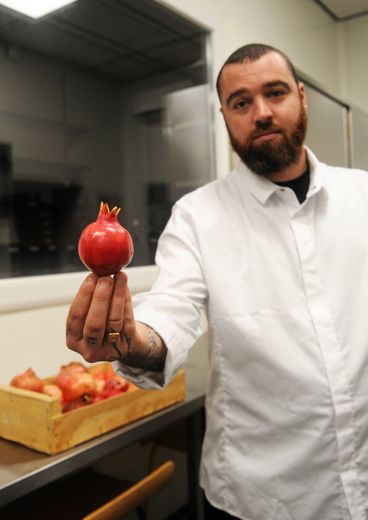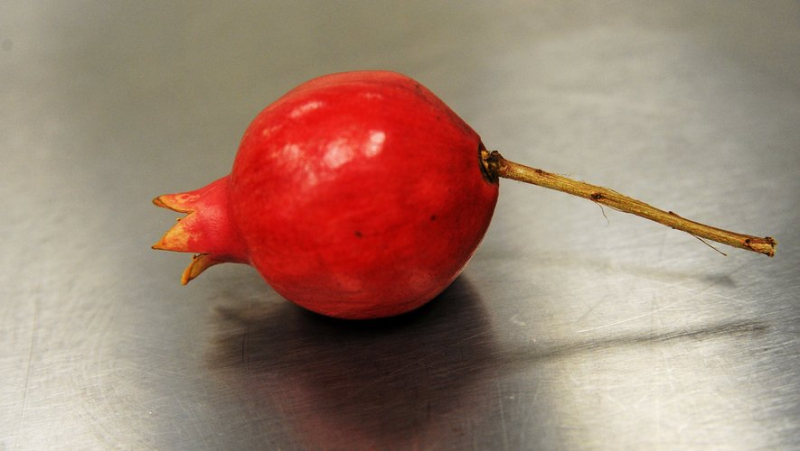When pomegranate brings new perspectives to local agriculture

Benjamin Mangin and Sébastien Vaissade, pomegranate ambassadors. Midi Libre – JEROME MOUILLOT


Health, flavors, colors, the pomegranate has more than one trick up its sleeve. Midi Libre – JEROME MOUILLOT

Après les vendanges, voici venu le temps de la récolte des grenades. Midi Libre – JEROME MOUILLOT
In the heart of Hérault, the pomegranate is making a place in the sun. A culture that complements that of the vine and the olive.
“We work the pomegranate on pastries, ice cream…", explains Benjamin Mangin, a chocolate maker and ice cream maker in Clermont, with his father Bernard Mangin, owner of the Chocolaterie du Blason. When planning to make 300 pomegranate ice cream logs for Christmas, “organic and local”, the artisan is savouring a fruit that inspires “Very fresh, very subtle sorbets with extraordinary colours that tend towards pink, red, it's very surprising. And it's essential for ice cream”.
A ramp-up in production
In Clermont, Le Blason is now one of Sébastien Vaissade's die-hard customers. For the past three years, once the grape harvest is over, the winegrower based in Liausson has been harvesting pomegranates. Because, in addition to its undeniable taste qualities, the fruit is a guarantee of numerous health benefits (antioxidant in particular). Highly sought after by athletes, it is also a promising asset for farmers who see, with this new sector, serious prospects for diversification in a context of global warming. “Today, I produce about one tonne per year, but I plan to increase the volume with new plantations (up to 10 tonnes) to be able to make fruit juices with a “health” range and a tasting range, perhaps in addition to other fruit juices”, reveals the farmer who is also an administrator of the Federation of Pomegranate Producers of the South*.
An asset for agricultural resilience
In our regions, after the historical cultures of vines and olives, that of the pomegranate is also taking root. “This product”offers great resilience in relation to the climate. For now, it is a niche market, I am not saying that in 10 years, 200,000 hectares of pomegranate trees will replace vines, but, for agriculture to be sustainable, it is part of diversification”. It opens up the field of possibilities in addition to traditional crops. Not to mention that pomegranate production is, “par excellence, zero pesticides” and that the fruit tree, native to Persia and Armenia, is well adapted to drought. The fact remains that, to further develop this nascent sector in the Cœur d'Hérault, a pressing tool would be very useful. “Today, pressing can only be done in Thuir or at a few rare individuals, such as in Bagnols”, explains Sébastien Vaissade. In the Cœur d'Hérault, a dedicated project could make its mark.
In ten years, pomegranate production has exploded
Still confidential ten years ago, in the South of France, pomegranate production is today “at least 550,000 tonnes recorded per year, without being exhaustive”, ées Pierre Colin, founding president, in 2014, of the Federation of Pomegranate Producers of the South (FPG Sud). Resilience of the crop in relation to global warming, the “has taken off. The popularity rating of the pomegranate is strong. The juice has interesting proven antioxidant and anti-cancer properties…” Beyond these benefits, in Languedoc Roussillon, “We take on the challenge of producing a juice that is as tasty as possible. First, we had to find good varieties to make the best possible juices because, as winemakers, as soon as we put a product in a bottle, we inevitably find ourselves facing a consumer who appreciates taste qualities as much as health benefits”. In addition, for the winemaker established in Pinet, (AOP Picpoul de Pinet), diversification has also made it possible to enhance land that was not classified as an appellation, “I wanted to create my own added value. In 2012, I discovered that I was not the only one. Hence the idea of bringing these farmers together and it was the Hérault Chamber of Agriculture that did the work of animation for this. And we created the federation in 2014”.
I subscribe to read the rest




